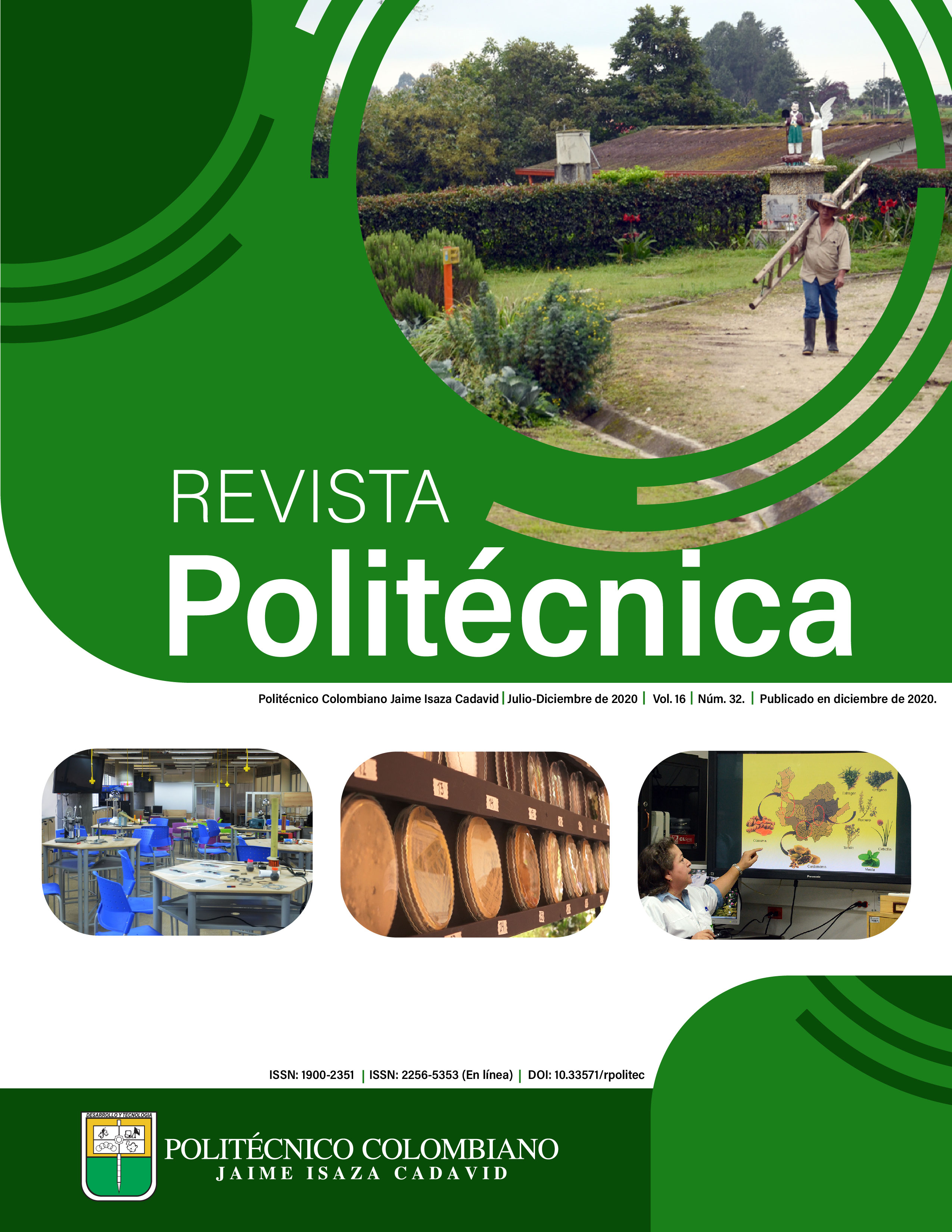Análisis de un controlador adaptable con observador de estado por modos deslizantes para un modelo de tratamiento de diabetes tipo 1
DOI:
https://doi.org/10.33571/rpolitec.v16n32a2Palabras clave:
Control Adaptable, Modelo Glucosa- Insulina, Diabetes Mellitus Tipo 1, observador por modos deslizantesResumen
El desarrollo del Páncreas Artificial, el cual consiste en la implementación de una bomba de infusión continua de insulina y de sensores para el monitoreo de glucosa en la sangre, es una prioridad para el tratamiento de personas con diabetes tipo 1. Para lograr la automatización completa de este proceso se han propuesto varias estrategias de control con el objetivo de mantener los niveles de glucosa en la sangre en el rango de normoglucemia. Entre las estrategias desarrolladas se destacan las basadas en control adaptable, para contrarrestar el efecto de las variaciones fisiológicas inherentes al paciente. Sin embargo, estas estrategias requieren la medición completa del estado, lo cual no es una tarea fácil debido al costo de los sensores y a la dificultad inherente en la medición directa de variables fisiológicas. Por lo tanto, en este trabajo se usa una estrategia de control adaptable con estabilidad garantizada para un modelo de control de insulina y se diseña un observador de estado no lineal por modos deslizantes, con el fin de estimar las variables de estado que requiere el controlador. Con el sistema completo control-observador se logran resultados satisfactorios al compensar la ingesta de alimentos y los errores entre los parámetros del modelo y del sujeto.
The development of the Artificial Pancreas, which consists of the implementation of a continuous insulin infusion pump and sensors for blood glucose monitoring, is a priority for the treatment of subjects with type 1 diabetes. To achieve a complete automation of this process several control strategies have been proposed with the aim of maintaining blood glucose levels in the normoglycemic range. Among the developed strategies, those based on adaptive control stand out, to counteract the effect of physiological variations that are inherent to the patient. However, these strategies require full state measurement, which is not an easy task because of sensors cost and the inherent difficulty in direct measurement of physiological variables. Therefore, in this work, an adaptive control strategy with guaranteed stability is used for an insulin control model, and a nonlinear sliding mode observer is designed to estimate the state variables that the controller requires. With the complete control-observer system, satisfactory results are obtained by compensating for meal intake and errors between the model and subject parameters.
Métricas de artículo
Resumen: 808 PDF: 283 HTML: 161Métricas PlumX
Citas
L. Poretsky, Principles of Diabetes Mellitus. New York: Springer, 2010.
A. E. Fathi, M. R. Smaoui, V. Gingras, B. Boulet, and A. Haidar, “The artificial pancreas and meal control: An overview of postprandial glucose regulation in type 1 diabetes,” IEEE Control Systems, vol. 38, no. 1, pp. 67–85, 2018.
R. Hovorka, “Continuous glucose monitoring and closed-loop systems,” Journal of Diabetes Science and Technology, vol. 23, no. 1, pp. 1–12, 2006.
J. E. Pinsker, E. Lee, J. B.and Dassau, D. E. Seborg, P. K. Bradley, R. Gondhalekar, W. C. Bevier, L. Huyett, H. C. Zisser, and F. J. Doyle, “Randomized crossover comparison of personalized mpc and pid control algorithms for the artificial pancreas,” Diabetes Care, vol. 39, pp. 1135–1142, 2016.
K. Turksoy and A. Cinar, “Adaptive control of artificial pancreas systems - a review,” Journal of Healthcare Engineering, vol. 5, no. 1, pp. 1–22, 2014.
A. Haidar, “The artificial pancreas: How closed-loop control is revolutionizing diabetes,” IEEE Control Systems, vol. 36, no. 5, pp. 28–47, 2016.
B. Grosman, E. Dassau, H. Zisser, L. Jovanovic, and F. J. Doyle III, “Multi-zone-mpc: Clinical inspired control algorithm for the artificial pancreas,” IFAC Proceedings Volumes (IFAC-PapersOnline), vol. 44, pp. 7120–7125, 2011.
K. Turksoy, E. S. Bayrak, L. Quinn, E. Littlejohn, and A. Cinar, “Multivariable adaptive closed-loop control of an artificial pancreas without meal and activity announcement,” Diabetes Technology and Therapeutics, vol. 15, no. 5, pp. 386–400, 2013.
A. Abu-Rmileh and W. Garcia-Gabin, “A gain-scheduling model predictive controller for blood glucose control in type 1 diabetes,” IEEE Transactions on Biomedical Engineering, vol. 57, no. 10, pp. 2478–2484, 2010.
D. Shi, E. Dassau, and F. J. Doyle III, “Adaptive zone model predictive control of artificial pancreas based on glucose- and velocity-dependent control penalties,” IEEE Transactions on Biomedical Engineering, vol. 66, no. 4, pp. 1045–1054, 2019.
Y. Wang, E. Dassau, H. Zisser, L. Jovanovic, and F. J. Doyle III,ˇ “Automatic bolus and adaptive basal algorithm for the artificial pancreatic β-cell,” Diabetes Technology and Therapeutics, vol. 12, no. 11, pp. 879–887, 2010.
N. Resalat, J. El Youssef, R. Reddy, J. Castle, and P. G. Jacobs, “Adaptive tuning of basal and bolus insulin to reduce postprandial hypoglycemia in a hybrid artificial pancreas,” Journal of Process Control, vol. 80, pp. 247–254, 2019.
A. Nath, D. Deb, R. Dey, and S. Das, “Blood glucose regulation in type 1 diabetic patients: an adaptive parametric compensation control-based approach,” IET Systems Biology, vol. 12, no. 5, pp. 219–225, 2018.
G.-B. Wang, S.-S. Peng, and H.-P. Huang, “A sliding observer for nonlinear process control,” Chemical Engineering Science, vol. 52, no. 5, pp. 787 – 805, 1997.
R. N. Bergman, L. S. Phillips, and C. Cobelli, “Physiologic evaluation of factors controlling glucose tolerance in man. measurement of insulin sensitivity and β-cell glucose sensitivity from the response to intravenous glucose,” Journal of Clinical Investigation, vol. 68, no. 6, pp. 1456–1467, 1981.
Y. Batmani, “Blood glucose concentration control for type 1 diabetic patients: a non-linear suboptimal approach,” IET Systems Biology, vol. 11, no. 4, pp. 119–125, 2017.
H. K. Khalil, Nonlinear Systems. Englewood Cliffs, NJ: PrenticeHall, 2nd ed., 1996.
F. Arscott and A. Filippov, Differential Equations with Discontinuous Righthand Sides: Control Systems. Mathematics and its Applications, Springer Netherlands, 1988.



 _
_






















